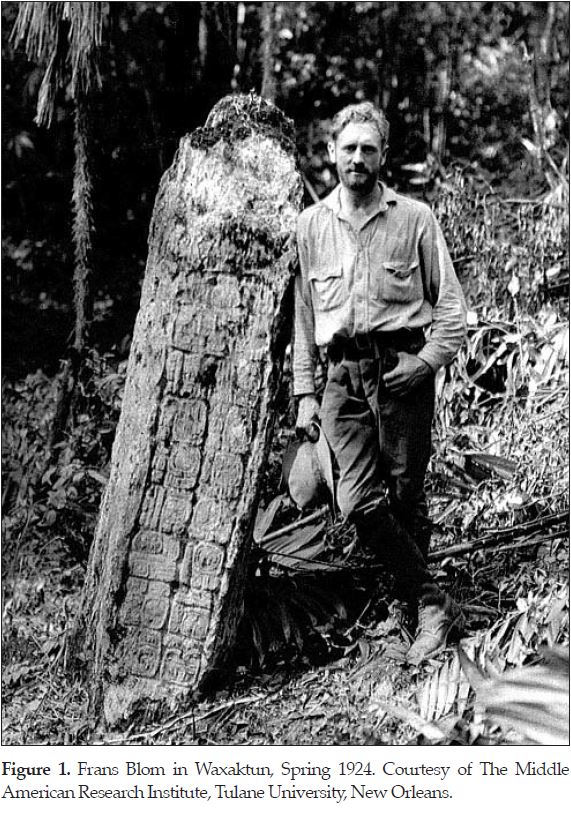
Born into a wealthy family in Copenhagen, Denmark, in 1893, Frans Ferdinand Blom lived the stereotypical rich kid life —dropping out of college, spending his parents’ money, and hanging out in cafes— until his mid-twenties, when his parents apparently had enough and shipped him off to Mexico to survive on his own. While working for an oil company, he began exploring and recording the many Mayan archaeological sites he visited, and found his true calling.
Impressed by his drawings, archaeologist Manuel Gamio hired him to spend several months in 1922 and 1923 clearing away the vegetation and mapping the ruins of Palenque, a Mayan site in Chiapas, Mexico. On the way to the site, the train he was on derailed. Soon after, he heard gunfire outside.
I did what every brave man should under such circumstances, I crouched down on the floor of the compartment, I had no intention of putting my head out the window to see what was up.
The train had been attacked by bandits, or perhaps rebels. The train crew returned fire, killing some of the attackers, and the rest fled.
With the help of Sylvanus Morley and Alfred Tozzer, a scholarship to Harvard University and fieldwork at Uaxactun in Guatemala and Pueblo Bonito in New Mexico followed. By 1925, M.A. in hand, he was hired by Tulane University in New Orleans. That year, he and Oliver Hazard Perry La Forge, an ethnologist, embarked on an expedition to Mexico in search of Mayan ruins. Traveling on horseback from village to village, they would ask the locals if they knew of any old stone monuments. Trying to relocate a town with stone ruins visited by Spaniards in A.D. 1518, their guides led them instead to a different site: La Venta.

There, they found a tree-covered stone pyramid, giant carved stone altar thrones, stela, and something completely unexpected. Almost completely buried in the dirt was a colossal stone head, almost eight feet tall and weighing over twenty tons. At the time, it’s creators were unknown, but now we recognize it as one of the most impressive and iconic artifacts of the Olmec culture. Named Monument 1, this colossal stone head was only partially excavated by Blom and La Farge. Although not directly dated, it is thought to be at least 3,500 years old. In 1940, another Jazz Age Adventurer, Matthew Stirling, would come to La Venta to finish excavating it. A local boy then led Stirling to three more colossal heads at the site.
By 1926, Blom was the director of the Department of Middle American Research at Tulane. In New Orleans, Blom immersed himself in the local culture, becoming part of an eclectic group of “Dixie Bohemians,” including a young William Faulkner, author Sherwood Anderson, and various other older and younger artists and free spirits who lived and played in the French Quarter. Blom, who liked to be called “Don Pancho,” joined in the fun, smoking Turkish cigarettes, drinking heavily, and introducing his friends to the arts and culture of Mexico.
His drinking led to serious problems in the 1930s, and he found himself divorced, out of his job, and out of money. This would have spelled the end for many people, but Blom moved permanently to Mexico, shook (at least temporarily) his drinking problem, and remarried, this time to Gertrude “Trudi” Duby, an anti-fascist social worker, anthropologist, and photographer originally from Switzerland. Frans and Trudi continued their research on both the ancient and modern Maya together. Their home, a former monastery in Chiapas they named Casa Na Bolom (Jaguar House), became both a rest house for travelers and a research center for study of the Lacandon Maya and the surrounding rain forest. Blom and Duby served as guides for other scientists, including a Berkeley expedition in search of amber in the 1950s.
Frans Ferdinand Blom died in 1963. Travelers can still get a meal and spend the night at Casa Na Bolom. Several of Trudi’s photos of Blom and other subjects can be seen at The Guardian.

References:
Blom, Frans F., and Oliver La Farge
1926 Tribes and Temples: A record of the expedition to Middle America conducted by the Tulane University of Louisiana in 1925. The Tulane University of Louisiania, New Orleans.
Grove, David C.
2014 Discovering the Olmecs: an Unconventional History. University of Texas Press, Austin.
Nielsen, Jesper
2003 Frans Blom and the Decipherment of Maya Writing. The PARI Journal 4(2):4-9.
Nielsen, Jesper, and Tore Leifer
2004 Return to the Great Forests: Frans Blom’s letters from Palenque, December 1922-March 1923. (Translated and with an introduction and notes by Nielsen and Leifer) The PARI Journal 4(3):7-10, 4(4):13-16, and 5(1):8-11.
Reed, John Shelton
2012 Dixie Bohemia: A French Quarter Circle in the 1920s. Louisiana State University Press, Baton Rouge.